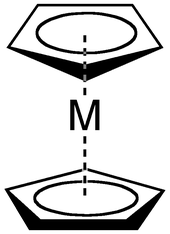- Metallocene
-
Metallocene sind Sandwichverbindungen mit zwei Cyclopentadienylresten. Sie sind also organometallische Komplexe der Form: M(Cp)2. Die 6 π-Elektronen des aromatischen Cyclopentadienylsystems binden gleichmäßig an das Metallatom. Weil 5 Kohlenstoffatome beteiligt sind, wird dies als η-5-Haptizität bezeichnet.
Metallocene müssen nicht nötigenfalls die 18-Elektronen-Regel erfüllen. Der Grund liegt in 5 nahe beieinander liegenden Energieniveaus. Diese können mit der MO-Theorie berechnet werden. Die Kristallfeldtheorie lässt dieses Ergebnis auch anschaulich verstehen: die dxz- und dyz-Orbitale, die in Richtung der Liganden zeigen werden stark destabilisiert. Das dz2-Orbital zeigt nur mit einer Komponente in Richtung der Liganden. Es wird weniger destabilisiert. Die tiefste Energie besitzen die beiden Orbitale in der xy-Ebene, die mit den Cp-Ringen nicht in Wechselwirkung treten.
Inhaltsverzeichnis
Nebengruppenmetallocene der 1. Periode
Als isolierbare Verbindungen treten die Metallocene von Vanadium bis Nickel auf. Vanadocen ist dabei als 15-Elektronenkomplex sehr instabil. Das einzig luftstabile Metallocen ist der diamagnetische 18-Valenzelektronenkomplex Ferrocen, es ist bei Temperaturen weit über 300 °C beständig.[1] Alle anderen Nebenruppenmetallocene der 1. Periode sind paramagnetisch und an Luft instabil. 19-Elektronen Cobaltocen wird leicht zum 18-Elektronen Cobaltociniumkation oxidiert. Es dient als 1-Elektronenreduktionsmittel. Umgekehrt ist (C5H5)2Fe+ ein 1-Elektronenoxidationsmittel. Beide können als Indikatoren für wasserfreie Redoxsysteme verwendet werden.
Erdalkalimetallocene
Auch die Metallocene der Erdalkalimetalle konnten zu Forschungszwecken synthetisiert werden. Nur Magnesiocen hat dabei die übliche Sandwichstruktur. Beryllocen kann mangels d-Orbitalen nur 8 Elektronen aufnehmen. Dies wird durch η-5-Koordination des einen und η-1-Koordination das anderen Ringes erreicht. Die Metallocene der schwereren Alkalimetalle zeigen den VSEPR-Regeln widersprechend eine gekippte Struktur. Die abgewinkelte Struktur geht auf die Polarisation des Kernes zurück, die durch die negativ geladenen Cp-Liganden hervorgerufen wird.
Metallocendihalogenide
Darunter versteht man Biscyclopentadienyl-Metall-Dihalogenide ((C5H5)2MX2, X= Halogen) sowie deren Derivate. Diese Verbindungsklasse hat große Bedeutung in der katalytischen Polymerisation von Olefinen erlangt. Sind beide Cyclopentantadienylringe kovalent miteinander verbunden (z.B. durch eine C2H4-Einheit) nennt man die resultierenden Komplexe ansa-Metallocene. Mit Hilfe C2-chiraler ansa-Metallocene (sogenannter Brintzinger-Typ) gelingt die stereospezifische Olefin-Polymerisation.
weitere Metallocene
Im weiteren Sinn werden unter dem Begriff Metallocenverbindungen auch Halbsandwich-Verbindungen verstanden, die nur ein Cyclopentadienyl-System über π-Bindungen an ein zentrales Metallatom gebunden besitzen. Die Absättigung freier (Elektronen-)Valenzen erfolgt über Stickstoff- oder Sauerstoffatome (z.B. Iminokomplexe). Zur Verbindungsklasse der Metallocene zählen manche Lehrbücher auch das Uranocen, obwohl es sich hierbei um einen Bis(cyclooctatetraenyl)-Komplex des Urans handelt.
Darstellungsmöglichkeiten
Beispiele
- Titanocen
- Chromocen
- Manganocen
- Ferrocen
- Cobaltocen
- Nickelocen
siehe auch
- Kaminsky-Katalysatoren
- Tebbe-Reagenz
- Liganden-Abkürzungen
- metallorganische Verbindungen
- Komplexchemie
- 18-Elektronen-Regel
- Molekülorbital
Literatur
- Christoph Elschenbroich: Organometallchemie, 6. Auflage, Wiesbaden 2008; ISBN 978-3-8351-0167-8.
Einzelnachweise
- ↑ Ivan Ernest: Bindung, Struktur und Reaktionsmechanismen in der organischen Chemie, Springer-Verlag, 1972, S. 51, ISBN 3-211-81060-9.
Wikimedia Foundation.





